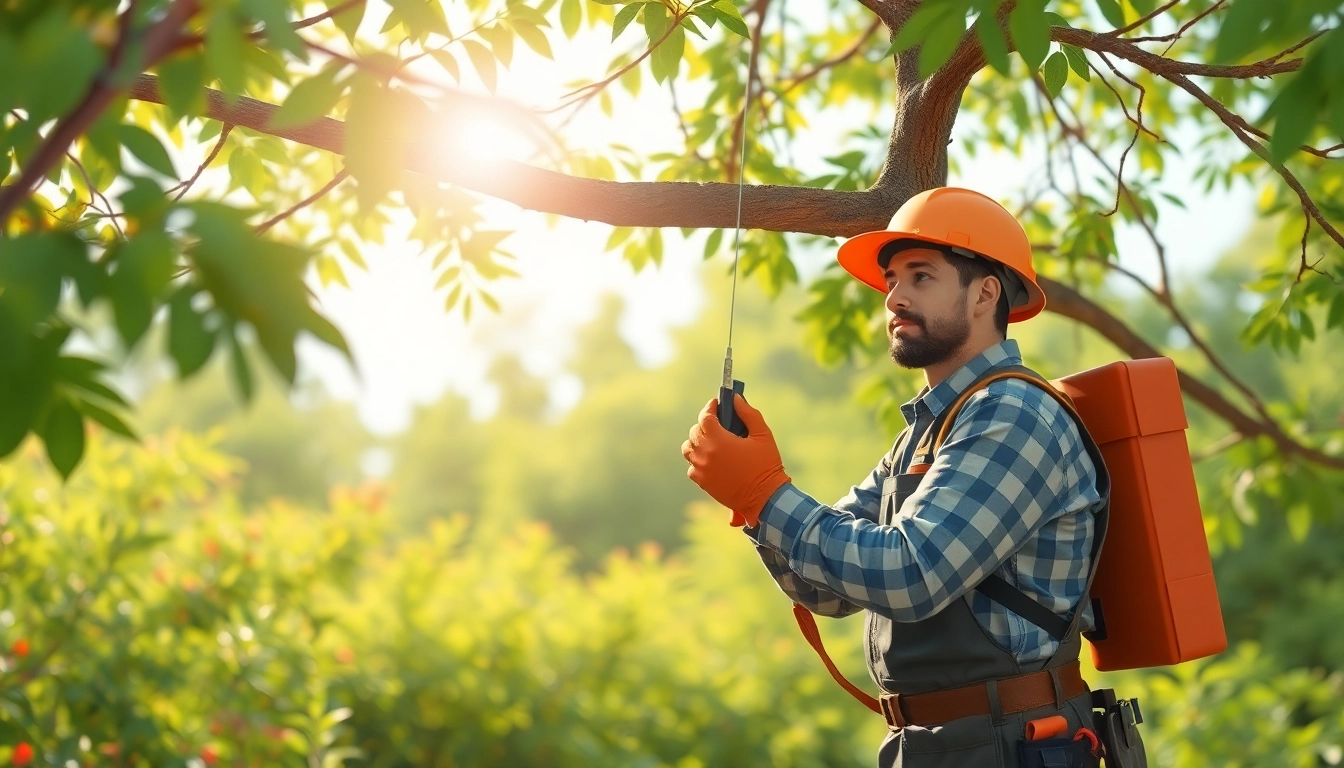Understanding Emergency Tree Services
When adverse weather events, natural disasters, or unforeseen circumstances threaten your trees, the necessity for an emergency tree service arises. These specialized services operate outside of standard tree maintenance schedules, addressing urgent and hazardous situations that require immediate intervention to ensure safety and preserve the overall health of the trees involved. Understanding what constitutes such emergencies and when to act can prevent further damage and safeguard your property.
What Constitutes an Emergency Tree Service?
Emergency tree services are defined by their rapid response to situations that pose immediate risks. These can include:
- Trees that have fallen or are at risk of imminent collapse.
- Branches that have broken and are hanging precariously over structures or power lines.
- Severe damage due to storms or natural disasters, such as hurricanes or tornadoes.
- Signs of pest infestations that could lead to hazardous conditions.
Such situations require certified arborists equipped with the necessary tools and expertise to handle complex tree emergencies safely and effectively.
Common Situations Requiring Immediate Action
Various situations necessitate emergency tree services, including the following:
- Storm Damage: Hurricanes, heavy winds, and storms can lead to broken branches or entire trees being uprooted. Quick removal is essential to prevent structural damage to homes or injuries to individuals.
- Tree Collapse: Aging or diseased trees may unexpectedly fall, especially after heavy rainfall or prolonged periods of drought. This unpredictable behavior can put properties at significant risk.
- Hazardous Growth: Trees that exhibit warning signs such as large splits, dead branches, or excessive leaning need immediate evaluation as they may pose a threat to nearby structures.
- Insect Infestation: Trees that have been infested with harmful pests may shed branches. If untreated, these trees can collapse and cause damage to surrounding areas.
Recognizing these scenarios will help homeowners understand when it’s time to call for professional help.
The Role of Certified Arborists in Tree Emergencies
Certified arborists play a crucial role in emergency tree services. Their qualifications ensure they are trained in assessing tree health and safety. They utilize their expertise to:
- Evaluate the structural integrity of trees to determine the best course of action.
- Implement safe removal techniques that minimize damage to the surrounding area.
- Provide guidance on tree health, offering advice on long-term solutions to prevent future emergencies.
- Utilize proper equipment and methods to execute rescue operations effectively while adhering to safety protocols.
Their involvement is essential for ensuring expert handling of the emergency while prioritizing safety and environmental considerations.
Assessing Tree Damage Safely
Evaluating tree damage should be approached with caution. Understanding the signs of distress is critical for homeowners to prevent injury and property damage.
Identifying Signs of Tree Distress
Monitoring trees for signs of distress can often prevent emergencies. Key indicators include:
- Leaf Discoloration: Yellowing leaves or premature leaf drop can indicate stress from pests, disease, or poor soil conditions.
- Crown Dieback: When the upper branches of a tree die or exhibit stunted growth, it signals that the tree may be unhealthy.
- Cracks or Splits: Visible damage on the trunk or large branches can weaken the tree’s structure, resulting in potential collapse.
- Lean: Trees that lean excessively may indicate root problems or diseases that weaken the tree’s stability.
Regularly assessing these signs can help in identifying potential issues before they escalate into emergencies.
Safety Precautions During Emergencies
Handling emergencies safely is paramount. Here are essential safety precautions:
- Keep a safe distance from fallen trees and broken branches that may still be connected to power lines.
- Do not attempt to remove large branches or trees yourself unless you are trained; always call professionals.
- Ensure the area is clear and that no individuals are in proximity to potentially falling debris.
- If necessary, contact local emergency services prior to tree services if there is a risk of danger from electrical elements.
Following these precautions not only ensures safety but also allows professionals to do their job effectively.
When to Call in Professionals for Emergency Tree Service
Understanding when to call in professionals is critical for ensuring safety and preventing further damage:
- If a tree has fallen on your home, car, or another structure, immediate professional assistance is needed.
- When large branches are hanging dangerously over your property due to storm damage.
- In cases where the structural integrity of the tree is compromised, like significant cracking or decay.
- If you notice an infestation that may lead to potential tree failure.
In all these situations, the sooner professionals can intervene, the better the outcome will be.
Emergency Tree Service Process
The emergency tree service process involves several critical steps to ensure effective and safe resolution of tree-related hazards.
Initial Assessment and Evaluation
Upon arrival, professionals will perform a thorough evaluation of the situation. This process includes:
- Assessing the extent of the damage and potential hazards around the area.
- Consulting with property owners about specific concerns and potential impacts on the landscape.
- Determining the best equipment and techniques for the job.
This meticulous assessment helps guide the approach to safely remove the tree or branches involved.
Clearance and Removal Techniques
Certified arborists utilize various techniques for clearance and removal, depending on the complexity and risk of the situation, including:
- Using Chippers: For quick disposal of smaller limbs and branches, chippers can reduce debris efficiently and safely.
- Climbing and Roping: In cases where trees are in challenging positions, arborists often utilize climbing gear and ropes to safely detach branches before removing them.
- Cutting Equipment: Chainsaws and handsaws are employed to make precise cuts to remove damaged sections without causing further hazard.
By employing these techniques, professionals can clear hazardous trees or branches effectively while minimizing area disturbance.
Post-Removal Yard Restoration
After successful removal, restoration is the next critical step. This includes:
- Cleaning the area of any remaining debris, ensuring no hazards are left around the property.
- Addressing potential soil contamination and assessing what may be needed for new plantings.
- Offering advice on follow-up tree care or replacements to ensure the yard’s continued health and aesthetics.
This comprehensive approach aids in restoring the landscape and preventing future issues.
Preventative Measures for Avoiding Emergencies
Preventing tree emergencies requires proactive and regular maintenance. Several measures can help keep trees healthy and reduce risks of emergencies.
Regular Tree Maintenance Tips
Implementing consistent maintenance practices is crucial for tree longevity. Consider these tips:
- Regularly inspect trees for signs of disease or damage.
- Prune trees annually to remove dead or weak branches.
- Maintain a proper watering schedule, particularly in times of drought.
- Apply mulch around the base to retain moisture and protect roots from extreme temperatures.
Commitment to these maintenance practices can substantially extend a tree’s life and health.
Proactive Seasonal Care
Seasonal changes can affect trees in various ways, so adjusting care throughout the year is essential. Some proactive measures include:
- Applying dormant oil in winter to prevent pest infestations.
- Conducting thorough checks after storms, particularly in spring and fall when storm activity is heightened.
- Inspecting root systems for signs of soil erosion or flooding.
- Adjusting care practices based on seasonal weather patterns to keep trees resilient.
Such approaches not only reduce the risk of emergencies but also promote long-term health.
Tools for Effective Tree Management
Utilizing the right tools can make a significant difference in tree care and management. Important tools include:
- Pruners: Essential for trimming small branches and managing growth.
- Chainsaws: Necessary for larger trees and branches.
- Brush Chippers: Valuable for disposing of trimmings and maintaining cleanliness.
- Soil Testing Kits: Help assess soil conditions to ensure proper nutrient levels for tree growth.
Ensuring that the proper tools are on hand helps in routine maintenance, making the process more effective and proactive.
Cost Considerations for Emergency Tree Services
Understanding the costs associated with emergency tree services is essential for homeowners. Multiple factors can influence pricing.
Factors That Influence Emergency Tree Service Pricing
Several elements contribute to the overall cost of emergency tree services:
- Severity of the Situation: More complicated removals or those involving risk factors (like power lines) usually incur higher charges.
- Time of Year: Services during peak seasons (like storm seasons) may be more expensive due to demand.
- Location: Costs may vary by geographical region and accessibility of the site.
- Extent of Work Required: Comprehensive cleanup post-removal also impacts pricing.
Being aware of these variables can help homeowners budget effectively for emergency tree needs.
Insurance and Emergency Tree Services
Understanding how insurance covers emergency tree services is vital:
- Homeowners’ insurance often covers tree damage, especially if the tree fell due to a covered event like a storm.
- Coverage specifics can vary greatly, so reviewing your policy is essential to determine what costs may be absorbed or need to be paid out-of-pocket.
- Filing claims promptly after a tree-related incident is crucial for insurance processing.
Homeowners are encouraged to communicate clearly with their insurance providers to fully understand their coverage regarding tree emergencies.
Budgeting and Planning for Tree Care
Investing in regular tree care can mitigate emergency costs in the long run. Key points for budgeting include:
- Allocating a specific budget for annual tree maintenance based on assessed risks.
- Setting aside an emergency fund for unexpected incidents that can arise.
- Consideration of prospective tree replacements should be factored into overall landscaping budgets.
By planning ahead, homeowners can effectively manage costs and prioritize tree health, leading to fewer emergencies.



